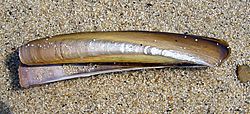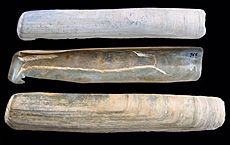Razor shell facts for kids
Quick facts for kids Razor shell |
|
|---|---|
 |
|
| Ensis arcuatis | |
| Scientific classification | |
| Kingdom: | |
| Phylum: | |
| Class: | |
| Order: |
Veneroida
|
| Family: |
Pharidae
|
| Genus: |
Ensis
|
| Species: |
E. arcuatus
|
| Binomial name | |
| Ensis arcuatus (Jeffreys, 1865)
|
|
Razor shells, also known as razor clams, are a type of shellfish that have two shells, like a clam or an oyster. They get their name because their long, narrow shells look a bit like an old-fashioned straight razor. These cool creatures use their strong shells to dig quickly into the sand, hiding themselves just below the surface.
The Ensis type of razor shell belongs to the Pharidae family. You can find them on sandy beaches in places like Northern Europe and Eastern Canada, including Prince Edward Island. One specific kind, Ensis arcuatus, prefers sand that's a bit rougher than what its relatives, E. ensis and E. siliqua, like.
There's also another family of razor shells called the Solenidae. Some scientists think Solen and Ensis are closely related. Others believe they look similar because they developed similar features over time to live in the same kind of environment. Scientists hope to learn more about this using special tests in the future.
Contents
What Do Razor Shells Look Like?
Razor shells can grow quite long, sometimes up to 23 centimetres (9.1 in). The top edge of their shell is straight, while the bottom edge is curved. It's easy to mix them up with E. ensis, which is a bit shorter (around 15 centimetres (5.9 in)) and has both its top and bottom edges curved in a similar way.
Razor shells have a shell that breaks easily, and both ends are open. The outside of the shell is smooth and whitish. It has reddish-brown or purplish-brown marks that run up and down, and also across, with a diagonal line separating them. The thin outer skin of the shell is olive-green. Inside, the shell is white with a hint of purple, and the razor shell's foot is creamy white with brown lines.
How Razor Shells Dig into the Sand
The razor shell lives under the sand. It uses its powerful foot, which is a large part of its body, to dig down to a safe depth. The digging process involves six steps that repeat over and over. Each digging cycle uses the strong foot and the opening and closing of one end of its shell.
First, the foot fills with water, making it swell up like a balloon. The razor shell then pushes this swollen foot down into the sand to hold itself in place. Next, the foot deflates, pulling the shell deeper into the sand. The razor shell also squirts water into the sand, which helps clear away loose sand from its path. The foot can push with a lot of force, about 2 kg/cm2!
You can often tell a razor shell is hiding under the sand by a keyhole-shaped hole it leaves on the surface. This hole is made by its siphons when it's feeding. Razor shells are filter feeders, meaning they suck in water to filter out tiny bits of plankton for food.
Reproduction and Life Cycle
Razor shells have a very organized way of reproducing. Both male and female razor shells release their eggs and sperm at the same time. This is called being "synchronous." During winter and spring, they have several times when they release eggs and sperm. These times are separated by periods when they produce more eggs and sperm for the next release.
Images for kids



